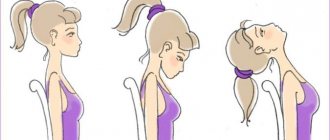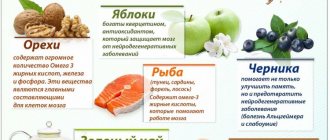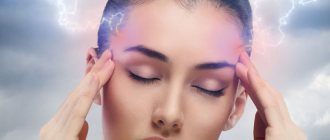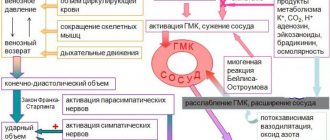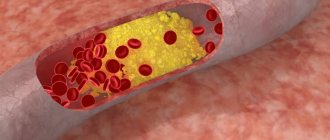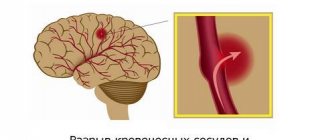Published: 07/23/2021 14:15:00 Updated: 07/23/2021
Atherosclerosis is a systemic disease that primarily affects the arteries. Cholesterol is deposited in the walls of blood vessels, resulting in the formation of plaques that interfere with normal blood flow. Internal organs experience a lack of oxygen and nutrients, and with the slow progression of the pathology, their work is gradually disrupted. In the case of acute thrombosis with complete blockage of blood flow, severe complications may develop - myocardial infarction, stroke, gangrene of the lower extremities and other dangerous pathologies.
Reasons for appearance
The appearance of atherosclerosis is associated with metabolic disorders in the body, lipid imbalance and excess cholesterol in the blood.
Mechanical damage to the vessel wall also plays an important role, contributing to atherosclerotic deposits and plaque formation at the site of injury. The risk of developing atherosclerosis is higher in men over 45 years of age, women over 55 years of age or with early menopause, as well as among people with familial hypercholesterolemia and family history, whose relatives already suffer from this disease.
Other factors contribute to it:
- unbalanced diet with an abundance of fatty foods;
- excess body weight;
- smoking;
- alcohol abuse;
- sedentary lifestyle;
- cardiovascular diseases – ischemic heart disease, arterial hypertension;
- endocrine pathologies, in particular diabetes.
Traditional methods of treatment - salvation from atherosclerosis?
Atherosclerosis - what is it?
Atherosclerosis is one of the dangerous common diseases that affects the blood vessels of our body. Plaques forming on the walls of blood vessels impede blood flow, which can lead to poor circulation in vital organs. And this, in turn, threatens myocardial infarction, stroke, intermittent claudication, etc.
Read materials on the topic:
How to prevent myocardial infarction?
How to prevent a brain catastrophe?
Obliterating atherosclerosis. How to treat?
Who is at risk and what are the factors contributing to the development of atherosclerosis?
People over 45 years of age, especially men, are at risk. An unhealthy lifestyle, a diet with a predominance of fatty foods rich in cholesterol, smoking, stress, physical inactivity are the main factors causing atherosclerosis.
You can learn more about cholesterol from our articles:
How to distinguish good and bad cholesterol?
Cholesterol Blood Test: Frequently Asked Questions
Traditional medicine against atherosclerosis: will it help?
Traditional treatment attracts many who want to get rid of atherosclerotic plaques. After all, it is much easier to take some kind of miraculous tincture than to change your lifestyle and diet.
Among the most popular folk methods for treating vascular atherosclerosis are garlic tinctures, taking olive oil, a mixture of honey, vegetable oil and lemon juice, nettle baths, tincture of tansy or hawthorn flowers, inhaling essential oils of juniper, mint, lavender, cumin.
Properly formulated herbal infusions can help only at the initial stage of the disease, but they should be used only as prescribed by a doctor. A more pleasant “method”, supposedly coming to us from French scientists, is taking mixtures based on dry red wine, which protects the body from many cardiovascular diseases.
In fact, there is no evidence of the effectiveness of any traditional methods of treating atherosclerosis. Otherwise, doctors would have adopted them long ago and saved many patients. Treatment of this disease should begin as early as possible. To do this, it is necessary to undergo appropriate diagnostics, which will allow the specialist to make the correct prescription.
Some methods of instrumental diagnosis of atherosclerosis
Research methods may include examination by a specialist, blood tests, ultrasound of the vessels of the neck, lower extremities, MRI of blood vessels, etc. Atherosclerosis of cerebral vessels is determined on MRI with fairly high accuracy. Therefore, this method is used not only to confirm or make a diagnosis, but also to monitor the effectiveness of treatment after operations to restore blocked vessels. Experts recommend undergoing vascular MRI, including for preventive purposes, 1-2 times a year.
Related material:
Magnetic resonance imaging as a method of choice in the diagnosis of neck vessels
You can sign up for a vascular ultrasound here
You can sign up for a vascular MRI here
ATTENTION: services are not available in all cities
The editors recommend:
How will MRI of cerebral vessels help a patient?
When is ultrasound of cerebral vessels prescribed?
Take care of your vessels! How not to miss vascular diseases of the brain?
Rules for healthy eating. What should you eat to stay healthy?
Classification of the disease
The formation of atherosclerotic plaques can occur in individual vessels or affect most of them. Depending on the organ in which blood flow is reduced and the affected artery, the following forms of the disease are distinguished:
- Heart shape. Ischemic atherosclerosis with damage to coronary vessels and valves.
- Kidney form. The renal arteries are affected.
- Brain (cerebral) form. The disease spreads to intracranial vessels.
- Intestinal form. The mesenteric arteries are affected.
- Atherosclerosis of the aorta. Its abdominal region is most often affected.
- Atherosclerosis of the arteries of the lower extremities, mainly femoral.
- Atherosclerosis of brachiocephalic vessels. These include the right carotid, vertebral and subclavian arteries.
Treatment of specific forms of the disease
Some folk remedies may be more effective depending on the location of the disease.
In cerebral form
In this form of the disease, the blood vessels of the brain are especially affected. A person’s memory and attention deteriorate, irritability increases, limbs may become cold and fainting may occur. Traditional medicine offers the following recipes for the treatment of cerebral atherosclerosis :
Pour dried apricots, raisins, prunes, rose hips and figs equally with the same amount of cold water. Leave for about 10 hours. Grind the swollen fruits in a meat grinder. Eat 1 tbsp. spoon of the resulting paste half an hour before meals.- For 1 part grated horseradish, take 10 parts sour cream. Eat 1-2 tbsp. spoon 30 minutes before meals.
- Mix 100 grams of onion juice with 100 grams of sugar. Leave in the dark for 24 hours. Drink a tablespoon after meals.
Drink 30-50 ml of brewed hawthorn berries before meals. To prepare the infusion, take 2 tbsp. spoons of berries per 300 ml of water.- Pour the crushed elecampane root with alcohol. 100 grams per 20 grams of raw materials. Leave for 20 days in the dark. Before use, mix with a bottle of pharmaceutical propolis tincture. Drink 25 drops morning and evening.
With obliterating endarteritis
To treat this disease, anticoagulants are used, which load the liver and kidneys in large quantities. You can partially replace chemicals with traditional medicine at home:
- Dilute horse chestnut juice with water 1:1. Drink 25 drops morning and evening. There are ready-made preparations from this plant.
- Drink 100 ml of cucumber juice on an empty stomach in the morning.
- 50 g of white mistletoe pour ½ liter of vodka. Leave in the dark for a month. Drink a small spoon 3 times a day. The course is limited to 3 months.
Atherosclerosis of the aorta of the heart
The most dangerous location for atherosclerosis is the aorta of the heart . Pathology that can lead to disability or death. For treatment at home, the following recipes are recommended:
- 150 gr. Garlic pulp needs to be poured with 250 grams of vodka. Keep in a dark place for 21 days. Take 20 drops diluted in 1/2 glass of milk.
- Take equal parts of finely chopped plantain leaf and fresh honey, mix and simmer in a water bath for 20 minutes. Take 1 tbsp. spoon per day. Store in a dark and cool place.
- 100 gr. Combine chopped garlic with 200 grams of fresh honey. Drink 20-30 minutes before meals 3-4 times a day.
Symptoms of atherosclerosis
For years and even decades, the disease can occur without clinical manifestations.
Subsequently, signs of poor blood supply to various organs are observed. With atherosclerosis of the heart, the patient is bothered by “squeezing” pain behind the sternum during physical activity - angina pectoris, arrhythmia, a feeling of palpitations accompanied by shortness of breath, and the development of myocardial infarction is possible.
In case of damage to the abdominal vessels, there may be attacks of pain in the upper and middle parts of the abdomen, which are accompanied by increased gas formation and constipation.
Atherosclerosis of the cerebral arteries manifests itself in dizziness and short-term episodes of loss of consciousness, and tinnitus. As the disease progresses, a stroke may develop with its neurological symptoms - dizziness, headache, lack of coordination and disorientation, numbness or weakness of the muscles of the face, arms or legs of one side of the body, sudden speech disturbances, visual disturbances, prolonged unconsciousness.
Vascular thrombosis of the lower extremities can lead to numbness and discoloration of the skin of the legs, a crawling sensation, and muscle pain when walking - “intermittent claudication.” Subsequently, the skin becomes thin and dry, peels, nails thicken, difficult-to-heal trophic ulcers form, and frequent cramps appear.
The main symptom of renal artery disease is an uncontrolled increase in blood pressure, leading to drug-resistant hypertension.
Treatment of cerebral atherosclerosis with folk remedies
For atherosclerosis of cerebral vessels, traditional medicine offers:
- infusion of burdock leaves;
- tea made from mint, hawthorn and motherwort;
- hibiscus and lemon balm tea;
- decoction of Caucasian dioscorea.
Buy hibiscus (hibiscus) (flowers) on our website
Multi-component herbal preparations that contain:
- lemon balm, mint, strawberry and nettle leaves;
- coltsfoot, hawthorn, mint, lemon balm;
- corn silk, mint, elecampane, lemongrass.
Effective folk remedies for treating cerebral atherosclerosis are alcohol tinctures:
- garlic;
- ginger with honey;
- dandelion root.
Advice! To cleanse the cerebral vessels, drink green tea, as well as beetroot or cabbage juices.
Diagnosis of atherosclerosis
The diagnosis is based primarily on the results of laboratory tests and data from instrumental research methods.
A conversation with a patient only allows us to identify risk factors for the development of diseases and, together with an examination, as well as consultation with other specialists, suggest which organs have already been affected by the disease. Diagnosis of atherosclerosis necessarily includes:
- Blood chemistry.
- Ultrasound of the heart and blood vessels.
- Electrocardiography.
A high predisposition to the development of the disease is indicated by changes such as an increase in the concentration of total cholesterol, triglycerides, low- and very low-density lipoproteins, and a decrease in the amount of high-density lipoproteins.
Innovative risk factors for atherosclerosis include C-reactive protein (CRP), apolipoproteins A1 (apoA1) and B-100 (apoB), some polymorphisms of endothelial synthase genes (NOS3G894T, NOS3T(-786)C) and blood coagulation factors FV and FII. To obtain accurate results of a blood test for atherosclerosis, three days before the test you should give up fatty, cholesterol-rich foods, and 8-10 hours before, eat nothing at all and drink a lot of liquid. 30 minutes before the test, you should avoid strong emotional stress, stress, and do not smoke.
Echocardiography clearly shows signs of atherosclerosis of the heart valves and aorta. According to indications, ultrasound scanning of the brachiocephalic, transcranial, and arterial vessels of the lower extremities is also performed.
Reflects disturbances in heart rhythm and electrical conductivity of the organ. Exercise testing may be performed to detect exertional angina.
The standard list of laboratory tests also includes a general clinical blood test and a general urinalysis.
Additionally, for the purpose of differential diagnosis, blood tests for the level of fibrinogen, homocysteine, antibodies to cardiolipin (IgG and IgM), and lupus anticoagulant may be recommended. To visualize atherosclerotic plaques, according to indications, angiography is used - an X-ray examination with the introduction of a contrast agent. In case of preparation for surgery on the heart vessels, coronary angiography is performed.
The “gold standard” for diagnosing pathological changes in the arteries of the brain and parenchymal organs is spiral computed tomography with contrast.
Often such patients are recommended to consult an ophthalmologist. Fundus ophthalmoscopy reveals signs of atherosclerotic damage to small retinal vessels.
Treatment
Treatment of atherosclerosis begins with correction of diet and lifestyle changes.
All patients are recommended to lose weight, moderate physical activity, and quit smoking and alcohol. Often the cause of atherosclerosis is a nutritional factor, so diet plays a very important role. To reduce the concentration of cholesterol in the blood, it is important to avoid meat broths, fatty, salty, smoked foods, semi-finished products, spicy, spicy, fried foods, and limit the consumption of table salt.
Prohibited products include:
- sugar;
- confectionery, sweets;
- mayonnaise, tomato and other store-bought sauces;
- bakery products made from wheat flour;
- offal;
- sweet carbonated drinks;
- industrially produced juices and nectars;
- cocoa;
- canned meat and fish;
- dried fruits high in sugars;
- strong coffee and tea.
It is recommended to eat split meals five times a day, including a sufficient amount of fiber, protein (lean meats and fish, low-fat cottage cheese), fresh vegetables (except potatoes), fruits, and dairy products.
Drug therapy is aimed at:
- decreased cholesterol synthesis (statins, fibrates);
- decreased absorption of fats from food (cholesterol absorption inhibitors, bile acid sequestrants);
- prevention of thromboembolic complications (antiplatelet agents);
- relief of symptoms of atherosclerosis (painkillers, antispasmodics).
To determine indications for surgical treatment, the degree of disruption of blood flow in the vessel is determined.
An overlap of its lumen of less than 50% is considered hemodynamically insignificant; with stenosis of 50-70%, only drug therapy is usually carried out. Correction of arterial obstruction surgically must be performed in the third stage of atherosclerosis and narrowing of the lumen by more than 70%. There are two main types of surgical intervention:
- Balloon angioplasty. A balloon is inflated inside the affected vessel, while the atherosclerotic plaque is flattened and evenly distributed along the artery wall. At the end of the manipulation, the device is removed.
- Arterial stenting. During the operation, a thin lattice cylinder is inserted and opened in the area of narrowing. It also presses against the plaque, but remains in the lumen of the vessel, gradually growing into its endothelium.
Treatment methods for atherosclerosis
Effective treatment of atherosclerosis must be comprehensive and include both drug and non-drug methods.
Drug therapy
Drug treatment for atherosclerosis is primarily aimed at reducing the synthesis of cholesterol by the patient’s body, reducing its intracellular content, enhancing the removal of cholesterol and its metabolites from the body, and inhibiting the absorption of cholesterol in the intestine.
Non-drug treatments
Non-drug treatment of atherosclerosis is aimed at eliminating modifiable factors of the disease. First of all, this:
- quitting smoking and alcohol abuse;
- normalization of body weight;
- proper nutrition. It is necessary to reduce the consumption of foods high in cholesterol (it is advisable to avoid fatty and fried foods). The optimal menu should contain a significant amount of vegetables and fruits rich in fiber and vitamins. And meat can (and should) be replaced with fish;
- increasing physical activity. Physical activity is necessary, but it must be dosed (agreed with your doctor). It is also important to ensure that the body receives enough oxygen (it is optimal to exercise in the fresh air);
- exclusion of conflict situations and overwork (anti-stress psychotherapy).
Make an appointment Do not self-medicate. Contact our specialists who will correctly diagnose and prescribe treatment.
Rate how useful the material was
thank you for rating
Complications
Atherosclerosis of the lower extremities is dangerous due to the development of gangrene, muscle atrophy, and thromboembolism of blood vessels of vital organs in the event of plaque rupture.
Cardiac complications with damage to the coronary vessels include myocardial infarction, focal dystrophy of the heart muscle, myocardiosclerosis, and coronary sclerosis.
With obstruction of the mesenteric arteries, ischemic colitis and intestinal gangrene are possible, and secondary arterial hypertension is possible in the renal arteries. Cerebral consequences include hemorrhagic and ischemic stroke, transient ischemic attacks, and atherosclerotic dementia.
An aortic aneurysm poses a danger to the patient's life, the rupture of which in most cases is fatal.
Prevention of atherosclerosis
For patients with a family history and age-related predisposition, a screening examination is recommended to determine the risk of developing cardiovascular pathology.
It aims to detect laboratory and genetic markers of the disease. Prevention of atherosclerosis includes weight control, proper nutrition, sufficient physical activity, giving up bad habits, and timely treatment of chronic diseases.
Author:
Pugonina Tatyana Alekseevna, Therapist

